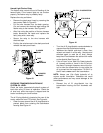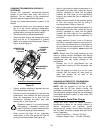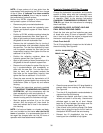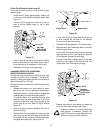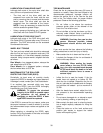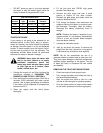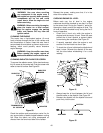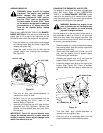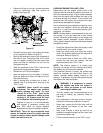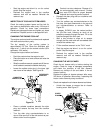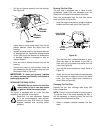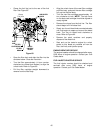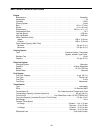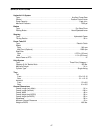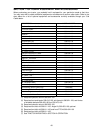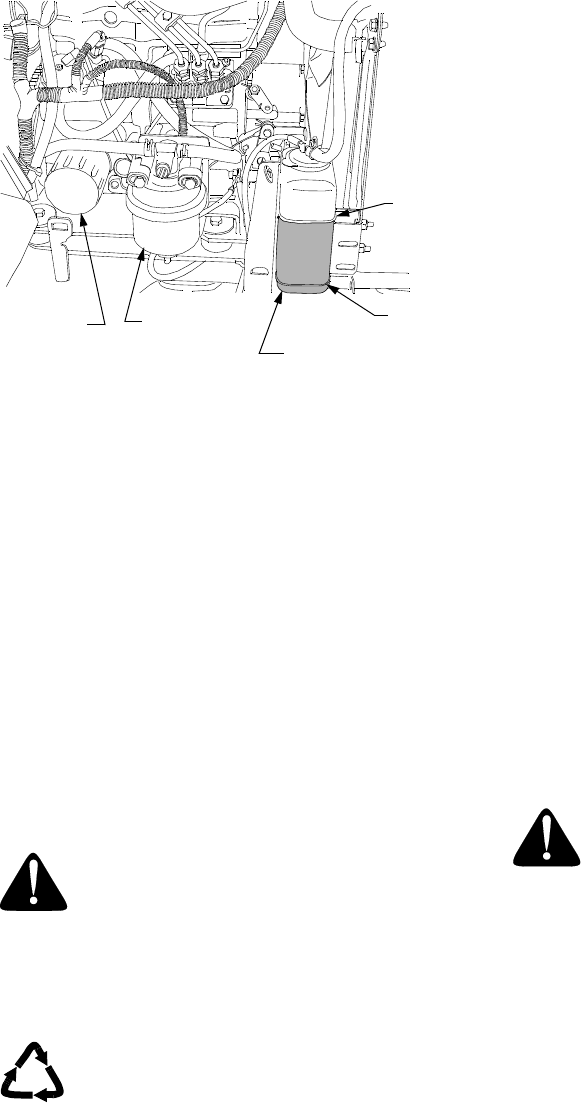
42
• Remove the filter by turning it counterclockwise
using an automotive type filter wrench to
loosen. See Figure 55.
Figure 55
• Reinstall the drain plug in the engine and clean
up any residual oil. Refer to Figure 54.
• Apply a light coating of clean oil on the gasket of
the new oil filter. Thread the filter on by hand
until the gasket contacts the filter base, then
tighten the filter an additional 3/4 turn. Do not
overtighten the filter.
• Refill the crankcase to the "FULL" mark on the
dipstick with the appropriate type oil.
• Reinstall the oil fill cap and dipstick.
• Start the engine and run for about 5 minutes.
Stop the engine and check for leaks at the oil
filter and drain plug.
• Wait 3 minutes and re-check the oil level. If
needed, add oil to bring the oil level up to the
"FULL" mark.
WARNING: Never overfill the engine
crankcase. The engine may overheat
and/or damage may result. For best
results, fill to the “FULL” mark on the
dipstick as opposed to adding a given
quantity of oil. Always check the level
on the dipstick before adding more oil.
Dispose of used oil in an environmentally
safe manner. If necessary, contact your
area EPA office for proper disposal
procedures and recycling center locations.
IMPORTANT: The oil fill cap and dipstick must
always be installed securely in place when the
engine is running. Severe engine damage could
result from failure to do so.
CHECKING ENGINE COOLANT LEVEL
Before each use, the engine coolant level in the
overflow reservoir should be checked to ensure it is
within the operating range. Engine coolant absorbs
heat from the engine and transfers the heat to the
air flowing through the radiator. If the coolant level
becomes low, the engine may overheat and could
cause severe damage to the engine.
Use a permanent type antifreeze containing corro-
sion and rust inhibitors. Dilute the antifreeze with
water at a 1:1 ratio to mix the coolant solution (50%
antifreeze : 50% water).
NOTE: Distilled water is recommended for the cool-
ant solution IF your tap water has a high mineral
content. Minerals cause scaling in the engine and
the radiator coolant passages. System efficiency
will be greatly reduced over time and severe engine
damage may result.
• Check the coolant level when the engine is cold
and the tractor is on a level surface.
• Raise the tractor hood and check the coolant
level in the overflow reservoir on the right side of
the engine. Refer to Figure 55.
• If the coolant level is below the "LOW" mark,
remove the cap from the reservoir and add
coolant solution to the "FULL" mark.
NOTE: The cooling system is a closed type.
Normally, to prevent air from entering the system,
the radiator cap should not be removed.
If the overflow reservoir is empty, the radiator cap
should be removed and the coolant level in the
radiator checked before adding coolant to the
reservoir. If necessary, first refill the system through
the radiator filler neck as follows:
WARNING: It is dangerous to remove
the radiator cap when the system is
hot. Allow the system to cool before
removing the radiator cap.
• Turn the radiator cap counterclockwise to the
first stop to release any pressure. Refer to
Figure 50.
• Push downward on the cap and turn counter-
clockwise until the cap stops then lift cap off.
• Slowly pour coolant into the filler neck until the
level reaches the bottom of the filler neck
overflow flange.
• Wait a few minutes to allow as much air as
possible to escape through the filler neck, then
reinstall the radiator cap.
• Fill the overflow reservoir to the "FULL" mark.
OIL
FILTER
FUEL
FILTER
COOLANT
RESERVOIR
FULL
MARK
LOW
MARK



